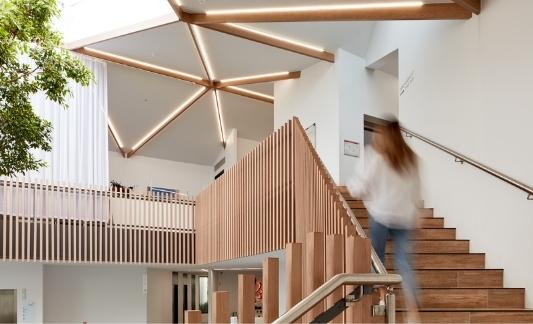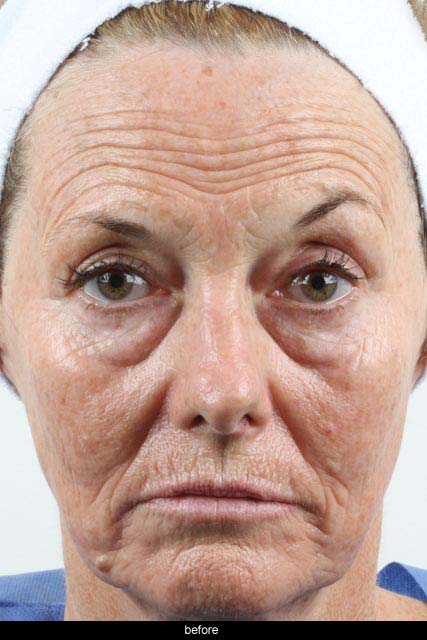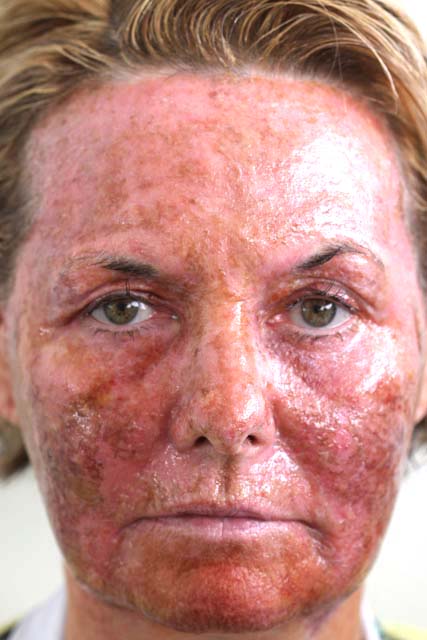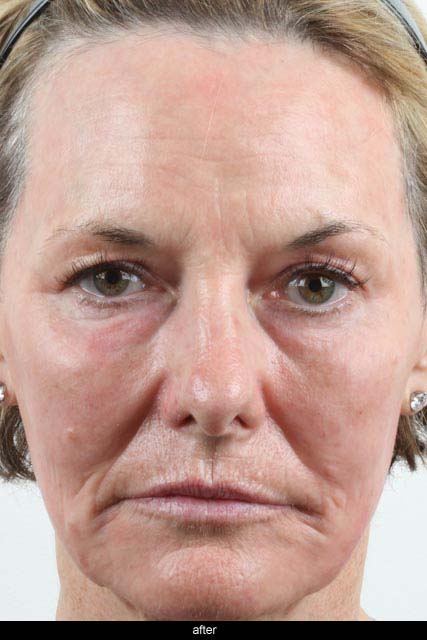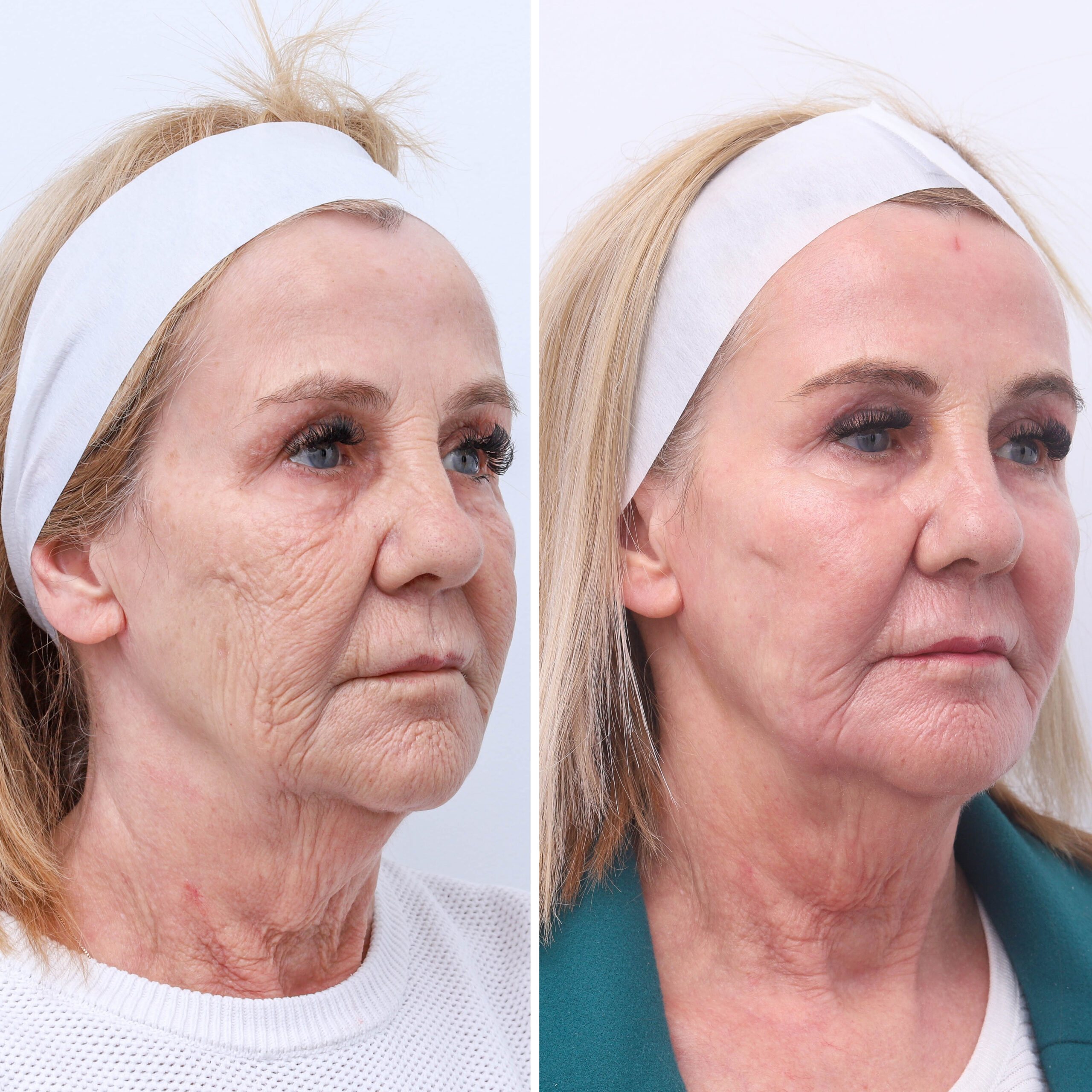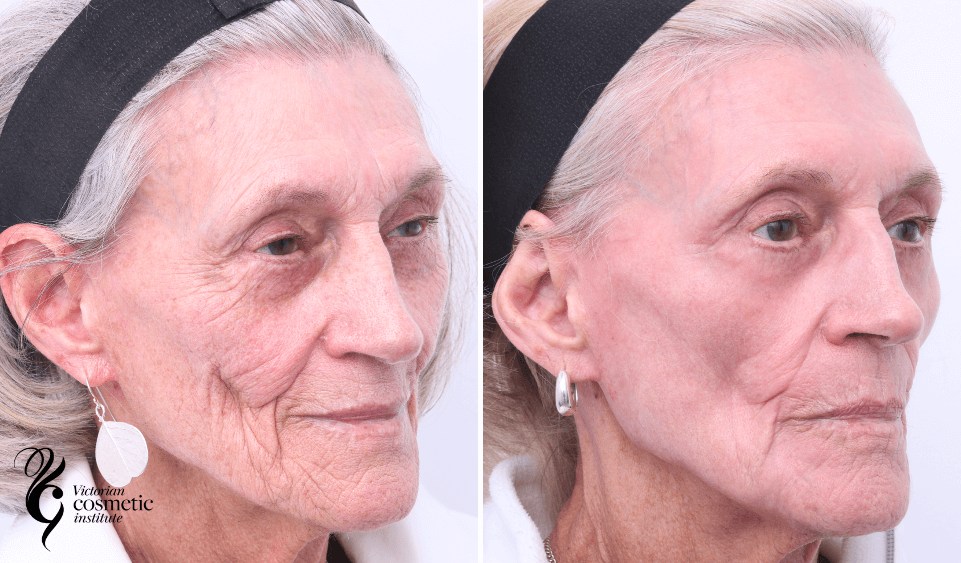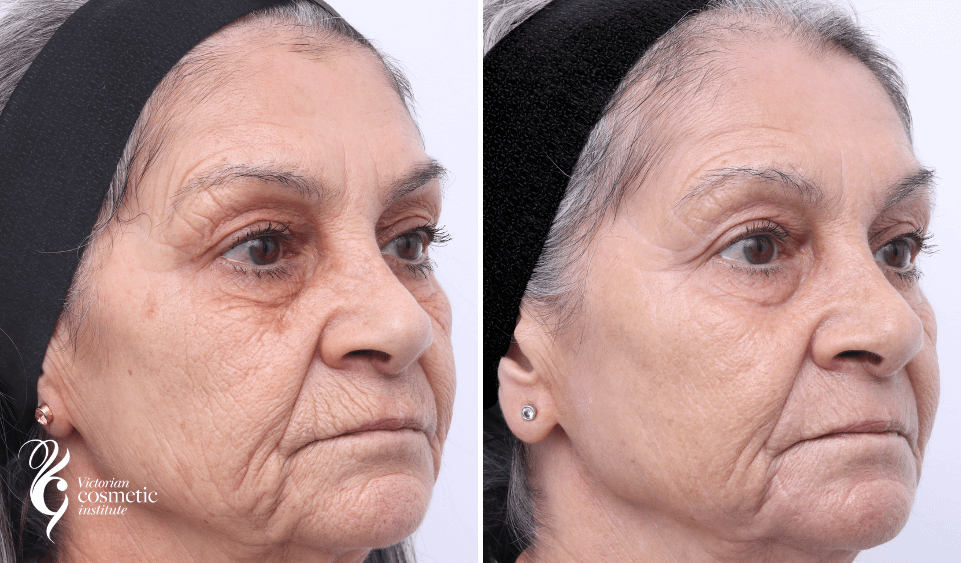Co2 Laser Treatment Melbourne
The Lumenis Ultrapulse carbon dioxide laser is highly effective for skin resurfacing and can be used in fractional or non-fractional modes.
The carbon dioxide laser improves skin texture and wrinkles on fairer skin types. It is also possible to be used in fractional mode to penetrate deeply into the skin to treat acne scarring.
A medical consultation is required to assess your presenting concerns and determine your suitability for any treatment.
What can be treated with the CO2 laser?
The CO2 laser can be used with two handpieces; an Active Fx handpiece and a Deep Fx handpiece.
Active Fx
The non-fractional, high-level CO2 treatments with the Active Fx handpiece are restricted to the face only and for those with fairer skin types. This treatment suits:
CO2 fractional laser with the Active Fx handpiece is commonly used as a lower-intensity treatment for the same concerns. This fractional approach reduces downtime and risk compared to non-fractional treatments.
Deep Fx
CO2 fractional laser with the Deep Fx hand-piece (a deeper penetrating fractional hand-piece) is used for scarring and can be used on fair to darker skin types. Using the Deep Fx, we can treat the following aspects of a scar;
- Scar texture
- Scar colour
- Skin flexibility as the laser helps to remodel the scar tissue.
Topical cortisone may be applied to the skin post-laser for hypertrophic or keloid scars, and this infuses into the channels created by the laser. The cortisone helps to reduce scar tissue activity and improve the appearance and flexibility of the scar. The laser therefore also not only remodels the scar, but provides a conduit for the delivery of medication through to the scar tissue. This may be a preferred alternative to injecting cortisone, which can, when delivered this way, cause atrophy of the scar or fat resulting in an indentation in the area.
Recovery from fractional Deep Fx treatment for scars is significantly less than the recovery from skin resurfacing for wrinkles using the same laser.
Because the carbon dioxide laser is able to ablate (vapourise) skin tissue, certain skin lumps and bumps can be treated with this laser, including benign nevi (moles).
Rhinophyma, an enlargement of the sebaceous glands on the nose that leads to a bulbous nose, can also be treated with the carbon dioxide laser. Rhinophyma is usually caused by an underlying skin condition called rosacea. The carbon dioxide laser can ablate the excessive sebaceous tissue and return the nose to its normal size and shape.
Am I a suitable candidate for CO2 laser treatment?
Suitabilty for CO2 laser treatment can only be determined in a medical consutlation. Those generally suitable for CO2 laser are those who want to:
- Improve skin texture
- Reduce wrinkles
- Improve Keloid / Hypertrophic scars
- Reduce skin pigmentation caused by sun exposure
- Reduce skin sallowness
- Tighten skin
It is important to note that non-fractional, high-level CO2 treatments, such as full-face resurfacing, are only suitable for individuals with fairer skin types who can manage a significant period of downtime of roughtly ten to fourteen days.
What is a carbon dioxide or CO2 laser?
The carbon dioxide (CO2) laser has a 10600 nanometre wavelength that is attracted to water. As water is one of the main constituents of the skin, when the laser interacts with it, a layer of skin is heated and vapourised. The heat energy causes contraction (tightening) of the skin, and the vapourised skin helps to remove surface issues such as wrinkles. This laser has been used for many years to resurface the skin and to reverse the effects of ageing and sun exposure. It improves skin texture, reduces wrinkles, and reduces pigmentation caused by sun exposure.
What is the difference between fractional and non-fractional treatment with the CO2 laser?
Fractional
In fractional mode, columns of laser energy are fired into the skin, leaving untreated skin in between. This reduces the recovery period required at the expense of the results achieved. Generally, more than one treatment is required if the laser is in fractional mode.
It is also possible in fractional mode to fire laser columns deeply into the skin. This is useful in treating scarring, where deeper collagen remodelling is required.
Finally, fractional CO2 can create deep channels in the skin to deliver drugs such as cortisone. This is effective for hypertrophic or keloid scarring or burn scars. The cortisone reduces the excess collagen production in scar tissue and improves the appearance of the scarring.
Non-fractional
As opposed to fractional mode, the CO2 laser treats 100% of the skin’s surface in non-fractional or full-field mode. Furthermore, more than one pass of the laser can be performed for greater results. This treatment requires a significant amount of recovery time.
What is Active Fx and Deep Fx?
Active Fx and Deep Fx are the names of the two handpieces that can be utilised with the Lumenis Ultrapulse CO2 laser.
The difference between the two handpieces is primarily in the size and depth of the columns of laser fired. The Active Fx handpiece emits laser columns with a diameter of 1.3mm and a depth of up to 0.2mm. This handpiece treats more superficial skin problems such as fine wrinkles, superficial sun damage, pigmentation, and skin sallowness.
The Deep Fx handpiece emits laser columns with a diameter of only 0.15mm, penetrating deeper, up to 2mm into the skin. This density or surface area covered is much less and ranges from 5 to 25%. This handpiece is used to treat deeper problems within the skin, such as scarring. The channels in the skin created by this handpiece can be used to deliver drugs to the skin. For example, cortisone can be delivered through these channels to help treat scars.
What is the difference between modern CO2 laser technology and older CO2 lasers?
CO2 lasers have been used for resurfacing the skin for over 30 years. Over time both the laser technology and the treatment techniques and methods have evolved, both helping to balance the potential risks and benefits of the treatment.
The introduction of fractional technology has improved the flexibility and uses of the CO2 laser. Fractional lasers fire small laser columns into the skin, leaving intact skin in between to help heal and reduce the risk and recovery from the laser. The CO2 laser can be used in fractional and non-fractional modes. This provides a significant advantage to traditional carbon dioxide lasers. Fractional CO2 technology also allows for deeper penetration of the laser into the skin, and the treatment of a greater variety of skin conditions.
Previously, many practitioners used the CO2 laser overly aggressively, and this produced unnatural-looking results, with skin often appearing hypopigmented (a decrease in skin pigmentation). As techniques have evolved, practitioners now better understand that a compromise is required, using less aggressive settings to achieve results that appear more natural and have fewer side effects or complications.
In summary, the main differences include;
| Traditional carbon dioxide laser | Lumenis Ultrapulse carbon dioxide laser |
| Fully ablates skin in the treatment area | Can be used in fractional or non-fractional modes |
| Shallow penetration into the skin | Depth of penetration into the skin is adjustable |
| Prolonged recovery periods | Potentially shorter recovery periods |
| May cause a waxy unnatural appearance to the skin | Less risk of waxy appearance to the skin |
| Higher risk of scarring | Lower risk of scarring |
| Progressive hypo-pigmentation (over-whitening of skin) | Reduced risk of hypo-pigmentation |
What is the difference between the Fraxel, Pearl fractional, other fractional lasers, and the Lumenis Ultrapulse laser?
There are other fractional carbon dioxide lasers from other manufacturers, however, at 60 watts, the Lumenis Ultrapulse is the most powerful. The other fractional carbon dioxide lasers including the Deka Smartxide, the Medart 610 laser, Ellipse Juvia, and the Fraxel re:pair laser. However, we have chosen the Lumenis Ultrapulse because of its superior flexibility and power to the other fractional carbon dioxide lasers.
The Fraxel re:store laser is also a fractional laser, but not a carbon dioxide laser. Instead this laser emits laser energy at 1550 nanometres. At this wavelength, no tissue is actually ablated (vapourised) and only tissue heating occurs. This can help with skin presentations such as acne scarring, but tends to be a less effective treatment than fractional carbon dioxide laser which both ablate and heat tissue to maximise the results.
Pearl fractional (2790 nanometres) and Pixel (2940nm) are also both fractional lasers, but again are not carbon dioxide lasers. The laser wavelengths of these two machines tend to ablate columns of skin, but unlike fractional carbon dioxide lasers, do not heat the skin to any large extent. As it is the heating which causes collagen contraction/skin tightening, these two lasers are limited as they do not cause much skin heating and are not used at Victorian Cosmetic Institute.
Who cannot have treatment with this laser?
We recommend those who are pregnant, breast-feeding, are prone to keloid scars, and those who have taken prescription vitamin A products in the past 6 months to avoid treatment.
The laser can also be used on most skin types from fair to dark, however, darker skin types may not be able to be treated with the same non-fractional settings as the fairer skin types due to the increased chance of darker skin types to have pigmentary disturbances post-laser.
How do I prepare for Co2 laser?
The first step of treatment involves preparing the skin for laser treatment. A good skincare regime with the required active ingredients can help to prepare the skin. Topical retinoids used on the skin prior to laser resurfacing can help to improve skin turnover and have been shown to reduce the time of re-epithelialisation (regeneration and reformation of skin) post-laser.
Especially for non-fractional high-level treatments which resurface the skin, antiviral medications or antibiotics may need to be taken prior to and after the procedure to prevent infections.
What should I expect during the treatment?
The anaesthesia for the treatment will depend on the level of treatment required and whether the Active Fx or Deep Fx handpiece is being used. For lighter treatments, a topical anaesthetic agent may be used without any other forms of anaesthesia. This will need to be applied approximately 60 minutes prior to the onset of the procedure. Non-fractional high-level treatments which resurface the skin are mostly performed under general anaesthetic.
During the treatment, your eyes will be covered, and for treatments around the eye area, corneal shields may need to be inserted under the eyelids to protect the eyes.
What happens after fractionated CO2 laser?
The treated areas appear red and swollen after the treatment, and the small columns of the laser can be seen on the face in a grid-like pattern of dots. The treated areas also feel quite hot after the procedure. To reduce this, we offer you a Zimmer cooler, a machine which blows cold air through a hose that can be directed at the areas to be treated.
There is a period where the skin appears quite red. Usually, this subsides within 1 week in lower energy level treatments. Swelling of the face/eyes may occur for a few days, and sleeping on a 45-degree angle or greater can help to reduce this. There may be a mild acne-like break out (small white pustules) on the face after 3 days as the skin regenerates. The skin may scab, peel and flake and this occurs over one week.
Fractional CO2 laser treatments typically take a lot shorter time to recover compared to non-fractional treatments. The recovery time will depend on the percentage of skin coverage as well as the intensity at which the laser is set.
What happens after non-fractionated CO2 laser?
With high-level non-fractional treatments, the skin’s barrier is significantly compromised. An occlusive skin product needs to be applied consistently post-treatment until the skin re-epithelialises. Usually, for these treatments, we advise face washing and re-application of occlusive skin care product 3 times a day. Antiviral medications or antibiotics may be required for this treatment. You will have a series of appointments with us following your laser treatment where we cleanse your face and closely monitor you for any signs of infection.
Swelling of the face/eyes may also occur, and we recommend sleeping on a 45-degree angle or greater can help to reduce this. On average 7-14 days at home are required to recover from the high-level non-fractional treatments.
FAQ
How much does Co2 laser cost?
The price of CO2 laser will depend on whether it is high level treatment or low level treatment, the handpiece that is used and what is being treated, as well as the size of the area to be treated. A quotation for treatment will be provided during your consultation appointment. The cost for a consulation can be foud here.
How long does it take to heal from CO2 fractional laser?
After CO2 fractional laser treatment, it takes 1 to 2 weeks for the skin to heal. During this time the skin will be very sensitive.
How long does it take to heal from CO2 non-fractional laser?
Healing from a CO2 non-fractional laser treatment typically takes about two weeks. During this time, patients can expect redness, swelling, and peeling as the skin regenerates. Residual redness will take several more weeks to subside, and mineral makeup can be used during that time. It’s crucial to follow post-treatment care instructions provided by your practitioner to ensure proper healing and minimise the risk of complications.
How do I prepare for the procedure?
Prior to the treatment, regular use of a SPF50+ broad spectrum sunscreen and limiting direct sunlight exposure is highly advised. Your doctor will advise you if other skin preparation products are required.
How many treatments of Co2 laser do I need?
What are the risks and side effects of CO2 laser?
There are risks and side effects associated with Co2 laser. These include:
- Milia – small white bumps that occur in the healing phase after CO2 laser. These can be easily removed by cleansing with a face cloth or you can visit one of our practitioners who can extract it for you
- Acne – it is possible for acne to occur after laser resurfacing. These generally resolve themselves
- Hyperpigmentation – pigmentation which forms as a response to the treatment
- Cold sores – taking antiviral medication prior the treatment and continuing for 7 to 10 days after treatment can reduce the risk of cold sores developing
- Bacterial infections – taking antibiotics prior the procedure and continuing for 7 to 10 days after treatment, and attending your post treatment appointments can reduce the risk of infection
- Scarring – this may occur following the treatment
Why choose Victorian Cosmetic Institute as your provider for Co2 Laser?
At Victorian Cosmetic Institute, our doctors are experienced in laser treatments, and will be able to give you detailed advice for your concern and any prescribed treatment. Your skin will be assessed and a detailed treatment plan provided, including details on costing for the treatment.
If the Co2 laser is not suitable for you, we have a variety of other lasers which may be suitable for the treatment of your skin.
Phone 1300 863 824 and one of our friendly Customer Care team members will find a suitable consutation time for you. Alternatively, you can book your consultation online.
Last updated July 2024
